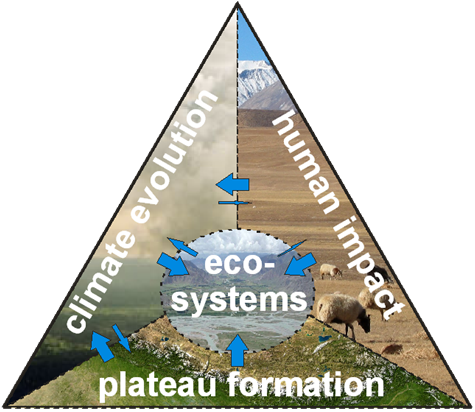Grazing Exclusion Experiment Xinghai, Tibetan Plateau
Xinghai 2009
Von 07/2009 bis 08/2009Mitarbeiter: Lena Becker, Georg Guggenberger, Silke Hafner, Yakov Kuzyakov, Xiaogang Li, Georg Miehe, Elke Seeber, Sebastian Unteregelsbacher, Karsten Wesche
In July and August 2009 a joint experiment of vegetation ecologist and soil scientists from the TiP Atmosphere- Ecology-Glacier (AEG) cluster was conducted near Xinghai in the Province of Qinghai on the north-eastern Tibetan Plateau. Collaborating scientists came from the Universität Bayreuth, the Georg-August-Universität Göttingen, the Leibniz Universität Hannover, the Philipps-Universität Marburg, Senckenberg Museum of Natural History Görlitz the Northwest Institute of Plateau Biology from the Chinese Academy of Science (CAS) Xining, and the Moe Key Lab of Arid & Grassland Ecology of Lanzhou University.

From left to right: The scientists in Xinghai and in the field, Georg Miehe and Chinese scientist examining vegetation changes seven years after fencing
Research focused on long term effects of grazing on vegetation biomass and composition as well as on carbon cycling in the plant-soil system. For this five grazing exclosure plots and adjacent grazed areas along an altitudinal (3000-3600 m a.s.l.) and precipitation (375-505 mm) gradient, representing the common vegetation types of the upper montane belt on the Tibetan Plateau, were compared. Three sites were dominated by Kobresia spp and the two others in the drier region were dominated by grasses, mainly Stipa spp. For detailed site description see Miehe et al. (2008)

From left to right: Kobresia spp. dominated pasture with Stellera chamaejasme, Geog Miehe in Stipa dominated grassland, potentially natural vegetation with Juniperus trees
Field work included analysis of vegetation biomass, composition and regrowth as well as description of soils. In order to assess the consequence of grazing exclosures on carbon and nitrogen cycling, 13C and 15N labeling experiments were carried out at one key site. Finally, vegetation and soil samples were taken from fenced and unfeced plots in five replicates for laboratory analysis. Those include DNA analyses of the plant species, changes in the belowground biomass, C and N contents in plants, bulk soil and different density fractions representing soil organic matter (SOM) of different turnover time, and biomarker analyses (lignin, suberin and cutin).

From left to right: Georg Guggenberger and Yakov Kuzyakov taking soil cores, Georg Guggenberger and Lena Becker opening the corer, Soil sample and tools

From left to right: scientists and local people harvesting aboveground biomass, Georg Miehe together with pasture owners estimating plant cover, local children interested in DNA sampling frame
G. Miehe, K. Kaiser, S. Co, Z. Xinguan, L. Jiuanquan (2008). Geo-ecological transect studies in northeastern Tibet (Qinghai, China) reveal human-made mid-holocene environmental changes in the upper Yellow River catchment changing forest to grassland. Erdkunde 62(3):187-199

